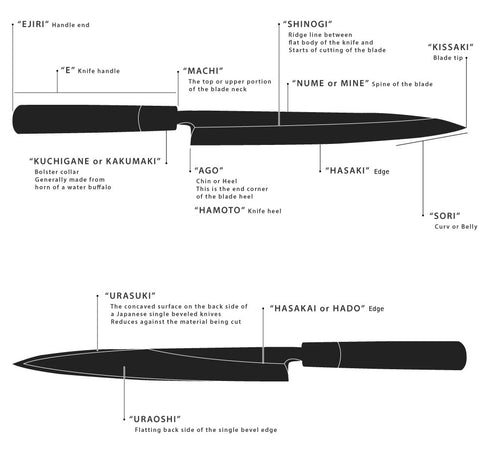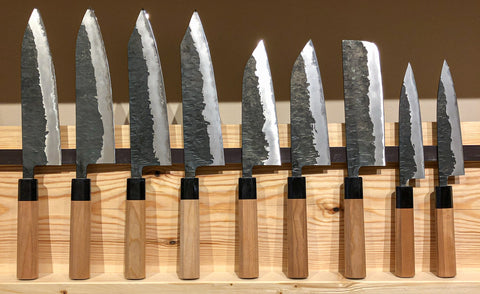Glossary of Knife Shapes and Terminology
Yanagiba, Yanagi: The Kansai style sashimi knife used for slicing and portioning fish.
Takohiki: Tokyo's style of sashimi knife used for slicing and portioning fish.
Deba: The Japanese style fish filleting knife also used to prepare shellfish and sometimes used as a butchery knife
Edo Usuba: The Tokyo style vegetable knife capable of extremely fine cutting.
Kamagata Usuba: Kansai's style vegetable knife capable of extremely fine cutting.
Fuguhiki: Similar in appearance to a Yanagi, the Fuguhiki is siginificantly thinner and is used for cutting fish very finely.
Gyuto: The Japanese style chefs knife designed for general purpose cutting.
Honesuki: A boning knife for breaking down poultry. Another variation called a Honesuki Maru is used for butchering larger animals.
Sujihiki: The Japanese style carving knife.
Santoku: A compact chefs knife designed for home cooking.
Study of Knife

Honyaki
Honyaki knives are made of a single piece of high carbon steel differentially hardened and quenched in water, some of the methods employed are derived from Japanese swordmaking. They are significantly harder than awase knives and tend to stay sharp much longer but they are much more delicate and require more skill and time to sharpen.
Kasumi
A misty finish created on a knife where both the hard and soft layers of steel are clearly visible; the cladding normally has a matt surface finish with the hard steel having more of a polished look.
Kurouchi
Kurouchi knives have the firescale from the forging left on the top of the blade, if the blade is made from carbon steel then this will act like a protective layer and won't discolour as easily as the ground area making them easier to maintain.
Nashiji
A Nashiji finish is when the fire scale is removed from a knife but the rough uneven surface underneath is deliberately left unpolished.
Damascus/Pattern welded steel/Suminigashi
Layers of alternating metals forge-welded together and repeatedly folded, this method produces striking patterns across the blade and can in cases increase the performance of coreless damascus blades.
San-Mai
A laminate of 3 layers of steel, the outside layers being soft cladding with the core being the hard steel that forms the cutting edge.
Warikomi
A core of high carbon steel is jacketed by soft iron, warikome differs from san-mai in that the bladesmith always performs the forge welding. Japanese bladesmiths sometimes buy pre-laminated san-mai billets.
Tsuchime
Decorative hammer beaten impressions or forging marks left on the Hira (top surface) of the blade which helps to reduce food sticking to the knife

